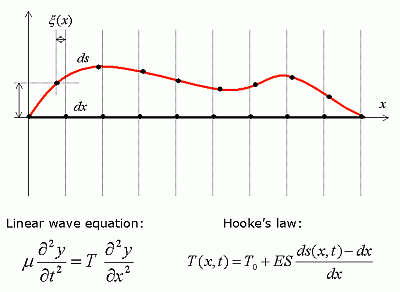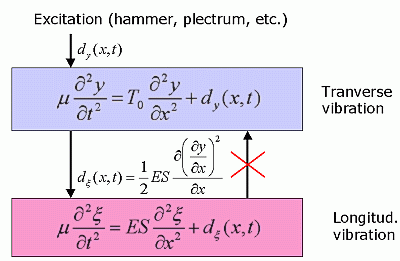|
Modeling the Nonlinar Vibrations of Strings
In the previous
page we have dealt with linear strings, where the string can be
described by methods of linear system theory (transfer function, impulse
response, etc.). The ideal string is characterized by the linear wave
eqation (see Fig. 1) where y is the displacement of the string at
the position x and time t, μ is
the mass per unit length, and T is the tension (the force applied
for stretching the string). The linear wave equation is obtained by
assuming that T is constant, i.e., the elongation coming
from the change of the string shape during vibration is negligible compared to
the initial elongation (or stretching). In this case the points of the string
move only in the y direction (i.e., perpendicular to the string).
However, in real instruments such components are also present
in the sound that cannot be modeled by linear theory. For example, the metallic
sound of low piano tones cannot be reproduced without modeling the
longitudinal motion, leading to the appearance of
phantom partials. Phantom partials are components that can be
found at certain sum- and difference-frequencies of the transverse
components.

Fig. 1. The geometric nonlinearity
If the string is modeled as a mass-spring network (the points
are the masses and the lines between them are the springs in Fig. 1), it is easy
to see that at larger amplitudes the points of the string are moving in
the x dircetion, too, as a point that is moved upwards
will pull the neighboring ones not only upwards but also towards itself.
This excites the longitudinal vibration, which was neglected in
the linear model. As a result, the distance of the points along the
string (which now equals ds, and is dx at rest)
will vary during vibration. This stretching or compression will lead to a
tension variation according to the Hooke's law, which adds up with the tension
at rest (T0) and gives the space- and
time dependent tension (T(x,t)). Accordingly, the
longitudinal vibration infulences the transverse one through the tension
variation. If we wish to model the phenomenon precisely, both the
transverse and longitudinal vibrations have to be modeled, toghether with
their mutual (and nonlinear) coupling. Note that this nonlinearity comes
from the geometry of the problem, and not from the nonlinearity of the string
material (as the Hooke's law was applied), hence, it is often called
geometric nonlinearity.
Computation of the mutual coupling of the two polarizations is
a complicated task, therefore often some simplifications are made. As an
example, it is usual to assume that the tension T does not depend on
space x, but it varies with time t. This can be used for
modeling pitch glides in loosely stretched strings, but it cannot describe the
generation of longitudinal vibration and phantom partials, which we are
aimed at. A better approximation for our purposes is when T depens both
on space and time, but we only model the coupling from the transverse to the
longitudinal polarization. In other words, in this model the transverse
vibration is not affected by the longitudinal one. This is illustrated in Fig.
2, where it can be seen that the response can be computed in a feedforward
way (step by step) as there is no feedback between the model blocks. The
transverse vibration can be computed by a linear string model (e.g. one of the
methods described for linear string
modeling) as a function of the excitation (plucking, strucking, etc.). The
longitudinal vibration can be computed by the same formalism, but now the
excitation is coming from the transverse vibration, and not from an external
device (plectrum or hammer). This feedforward (feedback-less) structure
makes the numerical implementation easier. Moreover, it gives the
opportunity of computing the string response in a closed form. The closed form
solution is of big help for understanding the phenomenon: it can be used for
describing the generatoin of phantom partials, which can be useful for
acousticians and instrument builders.

Fig. 2. Computation of the transverse and longitudinal
vibrations
Naturally, the numerical modeling of the mutual
(bi-directional) coupling of the transverse and longitudinal polarizations is
also possible. Real strings vibrate in two perpendicular transverse
polarizations (in the directions y and
z), which can be also modeled. In the case of bowed
strings, a forth polarization might need to be computed, as the bow excites
torsional vibration in the string, which is coupled with the other
polarizations. The question remains whether the significant increase
in computational complexity leads to a similar increase in sound quality.
Related publications:
|
Balázs Bank and László Sujbert, "Generation of longitudinal vibrations in piano strings:
From physics to sound synthesis,'' The Journal of the
Acoustical Society of America, vol. 117, no. 4, pp. 2268-2278, Apr. 2005.
Homepage |
The nonlinear vibration of the string and its significance for the
piano. Modeling by finite-difference amd modal based methods. |
|
Balázs Bank, Physics-based Sound Synthesis of String
Instruments Including Geometric Nonlinearities, Ph.D.
thesis, Budapest Univeristy of Technology and Economics, p. 142, Jun.
2006.
Homepage |
Chapter 5 is about the theory of geometric nonlinearities, while
Chap. 6 is about extending the existing linear string models for
longitudinal modeling. |
Further related papers can be downloaded from this page.
Further information: Balázs Bank
|